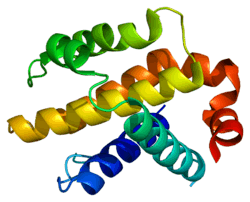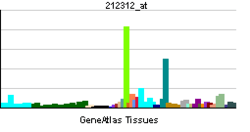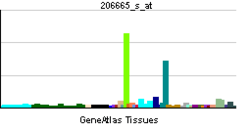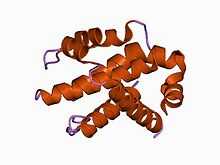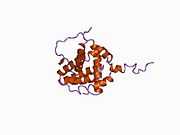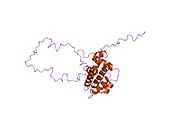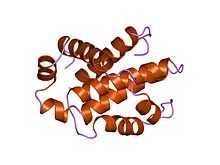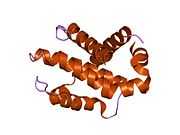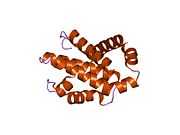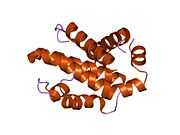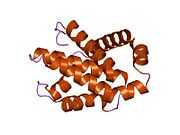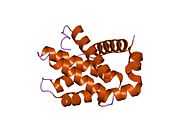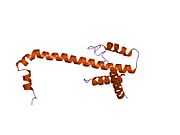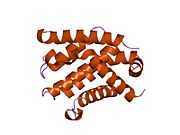BCL2-like 1 (gene)
Bcl-2-like protein 1 is a protein that in humans is encoded by the BCL2L1 gene.[1]
The protein encoded by this gene belongs to the BCL-2 protein family. BCL-2 family members form hetero- or homodimers and act as anti- or pro-apoptotic regulators that are involved in a wide variety of cellular activities. The proteins encoded by this gene are located at the outer mitochondrial membrane, and have been shown to regulate outer mitochondrial membrane channel (VDAC) opening. VDAC regulates mitochondrial membrane potential, and thus controls the production of reactive oxygen species(ROS) and release of cytochrome C by mitochondria, both of which are the potent inducers of cell apoptosis. Two alternatively spliced transcript variants, which encode distinct isoforms, have been reported. The longer isoform (Bcl-xL) acts as an apoptotic inhibitor and the shorter form (Bcl-xS) acts as an apoptotic activator.[2][3]
Interactions
BCL2-like 1 (gene) has been shown to interact with:
- APAF1,[4][5]
- BAK1,[6][7][8][9][10]
- BCAP31,[11]
- BCL2L11,[8][12][13][14]
- BNIP3,[15]
- BNIPL,[16][17]
- BAD,[7][12][18][19][20][21][22][23][24][25][26]
- BAX,[7][19][27][28]
- BIK,[6][12][28][29]
- Bcl-2,[7][30]
- HRK,[8][31][32]
- IKZF3,[33]
- Noxa,[12][34]
- PPP1CA,[20]
- PSEN2[35]
- RAD9A,[6][18]
- RTN1,[36]
- RTN4,[36] and
- VDAC1.[37][38][39][40]
References
- ↑ Boise LH, Gonzalez-Garcia M, Postema CE, Ding L, Lindsten T, Turka LA, Mao X, Nunez G, Thompson CB (September 1993). "bcl-x, a bcl-2-related gene that functions as a dominant regulator of apoptotic cell death". Cell 74 (4): 597–608. doi:10.1016/0092-8674(93)90508-N. PMID 8358789.
- ↑ "Entrez Gene: BCL2L1 BCL2-like 1".
- ↑ Boise et al. (Aug 27, 1993). "bcl-x, a bcl-2-related gene that functions as a dominant regulator of apoptotic cell death". Cell 74 (4): 597–608. doi:10.1016/0092-8674(93)90508-N. PMID 8358789.
- ↑ Hu Y, Benedict MA, Wu D, Inohara N, Núñez G (1998). "Bcl-XL interacts with Apaf-1 and inhibits Apaf-1-dependent caspase-9 activation". Proc. Natl. Acad. Sci. U.S.A. 95 (8): 4386–91. doi:10.1073/pnas.95.8.4386. PMC 22498. PMID 9539746.
- ↑ Pan G, O'Rourke K, Dixit VM (1998). "Caspase-9, Bcl-XL, and Apaf-1 form a ternary complex". J. Biol. Chem. 273 (10): 5841–5. doi:10.1074/jbc.273.10.5841. PMID 9488720.
- ↑ 6.0 6.1 6.2 Rual JF, Venkatesan K, Hao T, Hirozane-Kishikawa T, Dricot A, Li N, Berriz GF, Gibbons FD, Dreze M, Ayivi-Guedehoussou N, Klitgord N, Simon C, Boxem M, Milstein S, Rosenberg J, Goldberg DS, Zhang LV, Wong SL, Franklin G, Li S, Albala JS, Lim J, Fraughton C, Llamosas E, Cevik S, Bex C, Lamesch P, Sikorski RS, Vandenhaute J, Zoghbi HY, Smolyar A, Bosak S, Sequerra R, Doucette-Stamm L, Cusick ME, Hill DE, Roth FP, Vidal M (2005). "Towards a proteome-scale map of the human protein-protein interaction network". Nature 437 (7062): 1173–8. doi:10.1038/nature04209. PMID 16189514.
- ↑ 7.0 7.1 7.2 7.3 Zhang H, Nimmer P, Rosenberg SH, Ng SC, Joseph M (2002). "Development of a high-throughput fluorescence polarization assay for Bcl-x(L)". Anal. Biochem. 307 (1): 70–5. doi:10.1016/S0003-2697(02)00028-3. PMID 12137781.
- ↑ 8.0 8.1 8.2 Whitfield J, Harada K, Bardelle C, Staddon JM (2003). "High-throughput methods to detect dimerization of Bcl-2 family proteins". Anal. Biochem. 322 (2): 170–8. doi:10.1016/j.ab.2003.07.014. PMID 14596824.
- ↑ Willis SN, Chen L, Dewson G, Wei A, Naik E, Fletcher JI, Adams JM, Huang DC (2005). "Proapoptotic Bak is sequestered by Mcl-1 and Bcl-xL, but not Bcl-2, until displaced by BH3-only proteins". Genes Dev. 19 (11): 1294–305. doi:10.1101/gad.1304105. PMC 1142553. PMID 15901672.
- ↑ Degterev A, Lugovskoy A, Cardone M, Mulley B, Wagner G, Mitchison T, Yuan J (2001). "Identification of small-molecule inhibitors of interaction between the BH3 domain and Bcl-xL". Nat. Cell Biol. 3 (2): 173–82. doi:10.1038/35055085. PMID 11175750.
- ↑ Ng FW, Nguyen M, Kwan T, Branton PE, Nicholson DW, Cromlish JA, Shore GC (1997). "p28 Bap31, a Bcl-2/Bcl-XL- and procaspase-8-associated protein in the endoplasmic reticulum". J. Cell Biol. 139 (2): 327–38. doi:10.1083/jcb.139.2.327. PMC 2139787. PMID 9334338.
- ↑ 12.0 12.1 12.2 12.3 Chen L, Willis SN, Wei A, Smith BJ, Fletcher JI, Hinds MG, Colman PM, Day CL, Adams JM, Huang DC (2005). "Differential targeting of prosurvival Bcl-2 proteins by their BH3-only ligands allows complementary apoptotic function". Mol. Cell 17 (3): 393–403. doi:10.1016/j.molcel.2004.12.030. PMID 15694340.
- ↑ O'Connor L, Strasser A, O'Reilly LA, Hausmann G, Adams JM, Cory S, Huang DC (1998). "Bim: a novel member of the Bcl-2 family that promotes apoptosis". EMBO J. 17 (2): 384–95. doi:10.1093/emboj/17.2.384. PMC 1170389. PMID 9430630.
- ↑ Hsu SY, Lin P, Hsueh AJ (1998). "BOD (Bcl-2-related ovarian death gene) is an ovarian BH3 domain-containing proapoptotic Bcl-2 protein capable of dimerization with diverse antiapoptotic Bcl-2 members". Mol. Endocrinol. 12 (9): 1432–40. doi:10.1210/mend.12.9.0166. PMID 9731710.
- ↑ Ray R, Chen G, Vande Velde C, Cizeau J, Park JH, Reed JC, Gietz RD, Greenberg AH (2000). "BNIP3 heterodimerizes with Bcl-2/Bcl-X(L) and induces cell death independent of a Bcl-2 homology 3 (BH3) domain at both mitochondrial and nonmitochondrial sites". J. Biol. Chem. 275 (2): 1439–48. doi:10.1074/jbc.275.2.1439. PMID 10625696.
- ↑ Qin W, Hu J, Guo M, Xu J, Li J, Yao G, Zhou X, Jiang H, Zhang P, Shen L, Wan D, Gu J (2003). "BNIPL-2, a novel homologue of BNIP-2, interacts with Bcl-2 and Cdc42GAP in apoptosis". Biochem. Biophys. Res. Commun. 308 (2): 379–85. doi:10.1016/S0006-291X(03)01387-1. PMID 12901880.
- ↑ Yasuda M, Han JW, Dionne CA, Boyd JM, Chinnadurai G (1999). "BNIP3alpha: a human homolog of mitochondrial proapoptotic protein BNIP3". Cancer Res. 59 (3): 533–7. PMID 9973195.
- ↑ 18.0 18.1 Komatsu K, Miyashita T, Hang H, Hopkins KM, Zheng W, Cuddeback S, Yamada M, Lieberman HB, Wang HG (2000). "Human homologue of S. pombe Rad9 interacts with BCL-2/BCL-xL and promotes apoptosis". Nat. Cell Biol. 2 (1): 1–6. doi:10.1038/71316. PMID 10620799.
- ↑ 19.0 19.1 Strobel T, Tai YT, Korsmeyer S, Cannistra SA (1998). "BAD partly reverses paclitaxel resistance in human ovarian cancer cells". Oncogene 17 (19): 2419–27. doi:10.1038/sj.onc.1202180. PMID 9824152.
- ↑ 20.0 20.1 Ayllón V, Cayla X, García A, Fleischer A, Rebollo A (2002). "The anti-apoptotic molecules Bcl-xL and Bcl-w target protein phosphatase 1alpha to Bad". Eur. J. Immunol. 32 (7): 1847–55. doi:10.1002/1521-4141(200207)32:7<1847::AID-IMMU1847>3.0.CO;2-7. PMID 12115603.
- ↑ Jin Z, Xin M, Deng X (2005). "Survival function of protein kinase C{iota} as a novel nitrosamine 4-(methylnitrosamino)-1-(3-pyridyl)-1-butanone-activated bad kinase". J. Biol. Chem. 280 (16): 16045–52. doi:10.1074/jbc.M413488200. PMID 15705582.
- ↑ Yang E, Zha J, Jockel J, Boise LH, Thompson CB, Korsmeyer SJ (1995). "Bad, a heterodimeric partner for Bcl-XL and Bcl-2, displaces Bax and promotes cell death". Cell 80 (2): 285–91. doi:10.1016/0092-8674(95)90411-5. PMID 7834748.
- ↑ Petros AM, Nettesheim DG, Wang Y, Olejniczak ET, Meadows RP, Mack J, Swift K, Matayoshi ED, Zhang H, Thompson CB, Fesik SW (2000). "Rationale for Bcl-xL/Bad peptide complex formation from structure, mutagenesis, and biophysical studies". Protein Sci. 9 (12): 2528–34. doi:10.1110/ps.9.12.2528. PMC 2144516. PMID 11206074.
- ↑ Chattopadhyay A, Chiang CW, Yang E (2001). "BAD/BCL-[X(L)] heterodimerization leads to bypass of G0/G1 arrest". Oncogene 20 (33): 4507–18. doi:10.1038/sj.onc.1204584. PMID 11494146.
- ↑ Iwahashi H, Eguchi Y, Yasuhara N, Hanafusa T, Matsuzawa Y, Tsujimoto Y (1997). "Synergistic anti-apoptotic activity between Bcl-2 and SMN implicated in spinal muscular atrophy". Nature 390 (6658): 413–7. doi:10.1038/37144. PMID 9389483.
- ↑ Komatsu K, Wharton W, Hang H, Wu C, Singh S, Lieberman HB, Pledger WJ, Wang HG (2000). "PCNA interacts with hHus1/hRad9 in response to DNA damage and replication inhibition". Oncogene 19 (46): 5291–7. doi:10.1038/sj.onc.1203901. PMID 11077446.
- ↑ Sedlak TW, Oltvai ZN, Yang E, Wang K, Boise LH, Thompson CB, Korsmeyer SJ (Aug 15, 1995). "Multiple Bcl-2 family members demonstrate selective dimerizations with Bax". Proc. Natl. Acad. Sci. U.S.A. 92 (17): 7834–8. doi:10.1073/pnas.92.17.7834. PMC 41240. PMID 7644501.
- ↑ 28.0 28.1 Gillissen B, Essmann F, Graupner V, Stärck L, Radetzki S, Dörken B, Schulze-Osthoff K, Daniel PT (2003). "Induction of cell death by the BH3-only Bcl-2 homolog Nbk/Bik is mediated by an entirely Bax-dependent mitochondrial pathway". EMBO J. 22 (14): 3580–90. doi:10.1093/emboj/cdg343. PMC 165613. PMID 12853473.
- ↑ Jiang A, Clark EA (2001). "Involvement of Bik, a proapoptotic member of the Bcl-2 family, in surface IgM-mediated B cell apoptosis". J. Immunol. 166 (10): 6025–33. doi:10.4049/jimmunol.166.10.6025. PMID 11342619.
- ↑ Lin B, Kolluri SK, Lin F, Liu W, Han YH, Cao X, Dawson MI, Reed JC, Zhang XK (2004). "Conversion of Bcl-2 from protector to killer by interaction with nuclear orphan receptor Nur77/TR3". Cell 116 (4): 527–40. doi:10.1016/S0092-8674(04)00162-X. PMID 14980220.
- ↑ Inohara N, Ding L, Chen S, Núñez G (1997). "harakiri, a novel regulator of cell death, encodes a protein that activates apoptosis and interacts selectively with survival-promoting proteins Bcl-2 and Bcl-X(L)". EMBO J. 16 (7): 1686–94. doi:10.1093/emboj/16.7.1686. PMC 1169772. PMID 9130713.
- ↑ Imaizumi K, Morihara T, Mori Y, Katayama T, Tsuda M, Furuyama T, Wanaka A, Takeda M, Tohyama M (1999). "The cell death-promoting gene DP5, which interacts with the BCL2 family, is induced during neuronal apoptosis following exposure to amyloid beta protein". J. Biol. Chem. 274 (12): 7975–81. doi:10.1074/jbc.274.12.7975. PMID 10075695.
- ↑ Rebollo A, Ayllón V, Fleischer A, Martínez CA, Zaballos A (2001). "The association of Aiolos transcription factor and Bcl-xL is involved in the control of apoptosis". J. Immunol. 167 (11): 6366–73. doi:10.4049/jimmunol.167.11.6366. PMID 11714801.
- ↑ Oda E, Ohki R, Murasawa H, Nemoto J, Shibue T, Yamashita T, Tokino T, Taniguchi T, Tanaka N (2000). "Noxa, a BH3-only member of the Bcl-2 family and candidate mediator of p53-induced apoptosis". Science 288 (5468): 1053–8. doi:10.1126/science.288.5468.1053. PMID 10807576.
- ↑ Passer BJ, Pellegrini L, Vito P, Ganjei JK, D'Adamio L (1999). "Interaction of Alzheimer's presenilin-1 and presenilin-2 with Bcl-X(L). A potential role in modulating the threshold of cell death". J. Biol. Chem. 274 (34): 24007–13. doi:10.1074/jbc.274.34.24007. PMID 10446169.
- ↑ 36.0 36.1 Tagami S, Eguchi Y, Kinoshita M, Takeda M, Tsujimoto Y (2000). "A novel protein, RTN-XS, interacts with both Bcl-XL and Bcl-2 on endoplasmic reticulum and reduces their anti-apoptotic activity". Oncogene 19 (50): 5736–46. doi:10.1038/sj.onc.1203948. PMID 11126360.
- ↑ Weng C, Li Y, Xu D, Shi Y, Tang H (2005). "Specific cleavage of Mcl-1 by caspase-3 in tumor necrosis factor-related apoptosis-inducing ligand (TRAIL)-induced apoptosis in Jurkat leukemia T cells". J. Biol. Chem. 280 (11): 10491–500. doi:10.1074/jbc.M412819200. PMID 15637055.
- ↑ Shi Y, Chen J, Weng C, Chen R, Zheng Y, Chen Q, Tang H (2003). "Identification of the protein-protein contact site and interaction mode of human VDAC1 with Bcl-2 family proteins". Biochem. Biophys. Res. Commun. 305 (4): 989–96. doi:10.1016/S0006-291X(03)00871-4. PMID 12767928.
- ↑ Shimizu S, Konishi A, Kodama T, Tsujimoto Y (2000). "BH4 domain of antiapoptotic Bcl-2 family members closes voltage-dependent anion channel and inhibits apoptotic mitochondrial changes and cell death". Proc. Natl. Acad. Sci. U.S.A. 97 (7): 3100–5. doi:10.1073/pnas.97.7.3100. PMC 16199. PMID 10737788.
- ↑ Shimizu S, Narita M, Tsujimoto Y (1999). "Bcl-2 family proteins regulate the release of apoptogenic cytochrome c by the mitochondrial channel VDAC". Nature 399 (6735): 483–7. doi:10.1038/20959. PMID 10365962.
Further reading
- Ogata Y, Takahashi M (2004). "Bcl-xL as an antiapoptotic molecule for cardiomyocytes.". Drug News Perspect. 16 (7): 446–52. doi:10.1358/dnp.2003.16.7.829356. PMID 14668940.
| |||||||||||||||||||||||||||||||||
